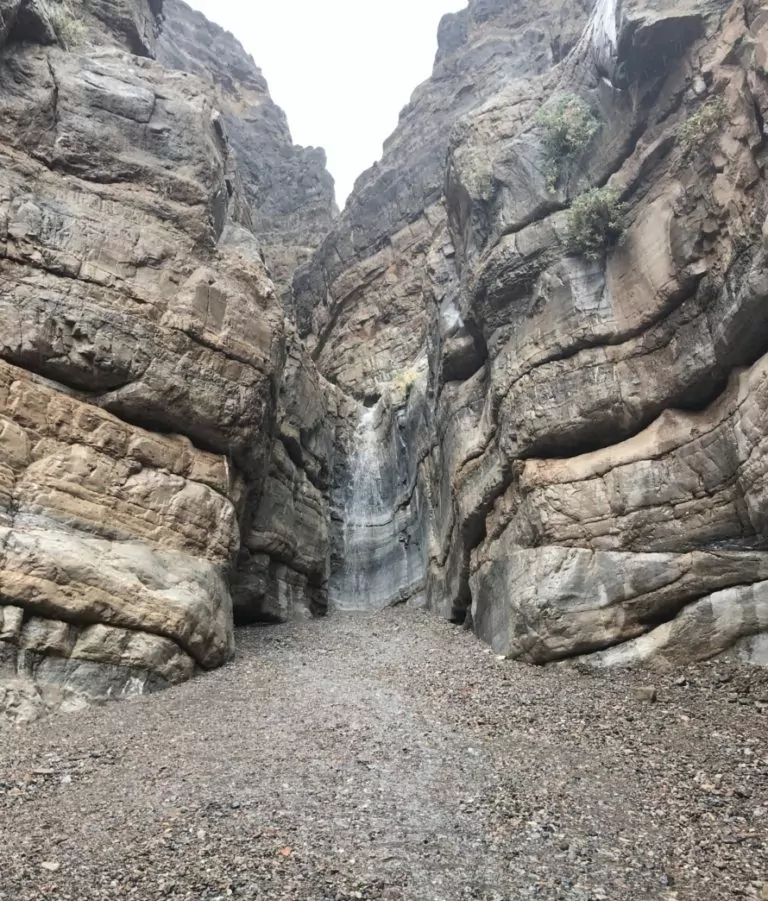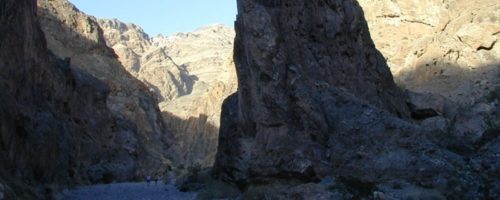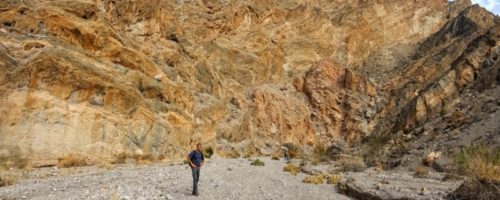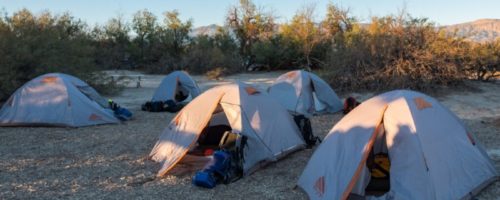
Fall Canyon Trail
General Description
Easy access, gentle grade, and colorful canyon walls extending 2000 feet above make Fall Canyon an outstanding hike in Death Valley National Park. Dropping into the wide wash of Fall Canyon, you will immediately know that you are in for something big. Along the hike, the canyon walls display vibrant reds, whites, blacks, and greys of geologic strata uplifted at varying angles. Wind your way up canyon passing intriguing side canyons to the base of a 20 foot dry fall. For most, the adventure stops here. A short stroll back will reveal a short slope scramble to bypass the falls on the south side. Adventurous souls will be treated to a beautiful section of narrows above the dry fall. The stunning narrows of lower Titus Canyon are a great way to add on a few miles. Whatever you fancy, Fall Canyon is a sure bet for a great hike.
Explore Death Valley with Expert Guides
Getting to the Fall Canyon Trailhead
From the Furnace Creek Visitor Center, take CA-190 W 17 miles to the junction with Scotty’s Castle Road. Take a right onto Scotty’s Castle Road and drive 15 miles to Titus Canyon Road on the right. The 3 mile access road is a graded gravel road accessible by most vehicles. High clearance is recommended. The parking area is at the mouth of Titus Canyon. To the right (north) side of the parking area, a faint trail follows along the cliff face. Follow this trail across the alluvial deposits until you drop down into the major wash of Fall Canyon.

3 Best Day Hikes Near the Fall Canyon Trail
Fall Canyon makes for a great half-day of exploration and adventure. If you are looking for other great hikes, check out these nearby trails.
| Destination | Miles | Elev | Difficulty | Style | |
| Titus Canyon | N/A | N/A | Easy | Out and Back/Drive | |
| Ubehebe Crater Trail | 0.5-2 mi | 300-1000 ft | Easy-Moderate | Out and Back /Loop | |
| Cottonwood-Marble Canyon Trail | 29-28 mi | 3800 ft | Strenuous | Loop |
1. Titus Canyon
Titus Canyon is one of the deepest and most awe-inspiring canyons found in Death Valley National Park. If you’re up for an incredibly scenic back country road, drive the 27 mile Titus Canyon Road, a narrow, twisting, one-way thrill ride. A high clearance vehicle will take adventurers up to the vibrantly colored hills of Red Pass. From here take a hike to nearby Thimble Peak, or descend into the Leadfield ghost town. Beyond Leadfield lies the lush Klare Spring and ancient Native American Petroglyphs. No high clearance? No problem! Hikers can stroll up the 1.5 miles of Titus Canyon’s astounding narrows, in some places only 20 feet wide and hundreds of feet deep. Check out nearby Fall Canyon if you are looking to put in a few more miles of hiking. However you choose to explore, Titus Canyon is a must do for any trip to Death Valley National Park.
2. Ubehebe Crater Trail
Ubehebe Crater is a stunning testament to Death Valley’s violent volcanic past. At 600 feet deep and one half mile across, Ubehebe is the largest of a series of craters that pockmark the area. Take a walk along the loop trail at the rim of the crater and explore several other smaller, more eroded craters. From the high point along the rim, observe the massive blanket of grey-black cinder; the result of Ubehebe’s eruption. Another great way to experience the enormity of Ubehebe is to take the short but steep trail to the bottom of the crater. Although the 600 feet of elevation gain to come back up doesn’t sound like much, it can seem twice as far when hiking up the steep, loose cinder trail. Hikers of all ages and abilities are sure to have a blast at Ubehebe Crater.
3. Cottonwood-Marble Canyon Trail
Hiking Cottonwood and Marble Canyons is the pinnacle of backpacking adventure in Death Valley National Park. This hike explores lush desert oases, ancient Native American petroglyphs, and some of the most astounding canyon narrows around. Lounge in the shade of a spring-fed cottonwood tree on a hike into Cottonwood Canyon. Hunt for ancient fossils and rock art in the masterfully sculpted narrows of Marble Canyon. None of the trail is developed and it requires good navigation skills. This is truly an unforgettable experience on the wild frontier of backpacking. Backpacking in Death Valley’s remote backcountry and arid climate should be approached with caution. Know your route and especially your water sources. Make this hike the one you remember for the rest of your life.
Maximize Your Visit to Death Valley National Park on a Hiking Tour
Guided multi-day packages allow visitors the opportunity to make the most of their time in Death Valley National Park and to do it hassle-free. Guided tours include gear (backpack, trekking poles, crampons in winter), meals, accommodations, local transportation, and a professional Death Valley hiking guide. Through their knowledge, stories, and personal passion, guides can bring a place to life in a way that’s much more difficult to do on your own. Read more about Death Valley Hiking Tours.
Award Winning USA Hiking Vacations

Join a Guided Death Valley National Park Backpacking Trip
Joining a Death Valley backpacking tour is a worry-free, adventurous way to experience Death Valley National Park. With your gear, meals, local transportation, permits, and fees taken care of for you, you can travel light and focus 100% on enjoying the hiking experience, while the guide company takes care of everything else. Also, by going with local experts you’ll enjoy a greater level of safety and gain a much better understanding of the history and ecology of this remarkable region. Read more about a guided Death Valley National Park backpacking trip.

When to Hike and Seasonal Considerations
The best season to hike the Fall Canyon Trail is from late fall to early spring. The approach hike is over open ground with no shade and is not advised during the late spring and summer months. Fall Canyon is prone to flash flooding so check the weather before you go.
Necessary Permits
Day Hikes
No permits are required for day hiking in Death Valley National Park.
Backpacking Permits
Backcountry camping permits are voluntary and may be obtained at the Visitor Center or any Ranger Station. Due to the extreme environment and remoteness, it is recommended that solo hikers and backpackers provide itinerary information and emergency contacts to park personnel.
Suggested Packing List
Day Hike Packing List
- 3-4 liters of water per person
- Salty, calorie-rich snacks
- lunch
- backpack
- trekking poles
- crampons (in winter)
- wide-brimmed hat
- sunscreen, sunglasses
- cotton t-shirt (spring-fall)
- non-cotton t-shirt (winter)
- rain jacket
- warm non-cotton layer
- 1st-aid kit
Backpacking Packing List
- all items listed for day hikes PLUS
- additional water AND water filter/purification method
- multi-day backpack
- 3-season tent
- sleeping bag
- sleeping pad
- backpacking stove and fuel
- backpacking meals
- 2-3 pairs wool socks
- extra t-shirts
Please Respect Our National Parks – Leave No Trace
We strongly recommend abiding by all Leave No Trace ethics guidelines and practices so that our national parks and public lands are preserved for the enjoyment of future generations and for the people and animals who call these places home. Simple things like packing out your trash, obeying national park rules, and respecting the peace and quiet of our national park trails is a great start. If you’re going on a backpacking trip, you can read about more about the 7 Leave No Trace Principles.




